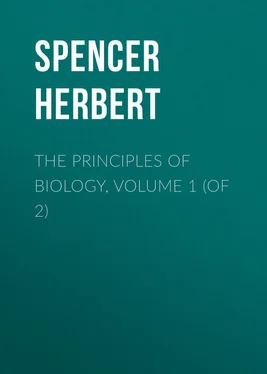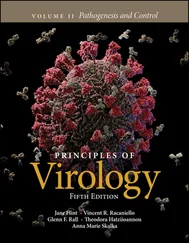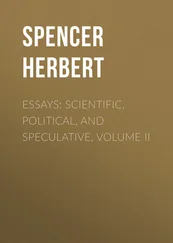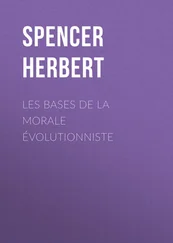Herbert Spencer - The Principles of Biology, Volume 1 (of 2)
Здесь есть возможность читать онлайн «Herbert Spencer - The Principles of Biology, Volume 1 (of 2)» — ознакомительный отрывок электронной книги совершенно бесплатно, а после прочтения отрывка купить полную версию. В некоторых случаях можно слушать аудио, скачать через торрент в формате fb2 и присутствует краткое содержание. Жанр: Философия, foreign_antique, foreign_prose, на английском языке. Описание произведения, (предисловие) а так же отзывы посетителей доступны на портале библиотеки ЛибКат.
- Название:The Principles of Biology, Volume 1 (of 2)
- Автор:
- Жанр:
- Год:неизвестен
- ISBN:нет данных
- Рейтинг книги:3 / 5. Голосов: 1
-
Избранное:Добавить в избранное
- Отзывы:
-
Ваша оценка:
- 60
- 1
- 2
- 3
- 4
- 5
The Principles of Biology, Volume 1 (of 2): краткое содержание, описание и аннотация
Предлагаем к чтению аннотацию, описание, краткое содержание или предисловие (зависит от того, что написал сам автор книги «The Principles of Biology, Volume 1 (of 2)»). Если вы не нашли необходимую информацию о книге — напишите в комментариях, мы постараемся отыскать её.
The Principles of Biology, Volume 1 (of 2) — читать онлайн ознакомительный отрывок
Ниже представлен текст книги, разбитый по страницам. Система сохранения места последней прочитанной страницы, позволяет с удобством читать онлайн бесплатно книгу «The Principles of Biology, Volume 1 (of 2)», без необходимости каждый раз заново искать на чём Вы остановились. Поставьте закладку, и сможете в любой момент перейти на страницу, на которой закончили чтение.
Интервал:
Закладка:
Looking at the evidence thus brought together, do we not get an insight into the actions of nitrogenous matter as a worker of organic changes? We see that nitrogenous compounds in general are extremely prone to decompose: their decomposition often involving a sudden and great evolution of energy. We see that the substances classed as ferments, which, during their own molecular changes, set up molecular changes in the accompanying carbo-hydrates, are all nitrogenous. We see that among classes of organisms, and among the parts of each organism, there is a relation between the amount of nitrogenous matter present and the amount of independent activity. And we see that even in organisms and parts of organisms where the activity is least, such changes as do take place are initiated by a substance containing nitrogen. Does it not seem probable, then, that these extremely unstable compounds have everywhere the effect of communicating to the less unstable compounds associated with them, molecular movements towards a stable state, like those they are themselves undergoing? The changes which we thus suppose nitrogenous matter to produce in the body, are clearly analogous to those which we see it produce out of the body. Out of the body, certain carbo-hydrates in continued contact with nitrogenous matter, are transformed into carbonic acid and alcohol, and unless prevented the alcohol is transformed into acetic acid: the substances formed being thus more highly oxidized and more stable than the substances destroyed. In the body, these same carbo-hydrates, in continued contact with nitrogenous matter, are transformed into carbonic acid and water: substances which are also more highly oxidized and more stable than those from which they result. And since acetic acid is itself resolved by further oxidation into carbonic acid and water; we see that the chief difference between the two cases is, that the process is more completely effected in the body than it is out of the body. Thus, to carry further the simile used above, the molecules of carbo-hydrates contained in the tissues are, like bricks on end, not in the stablest equilibrium; but still in an equilibrium so stable, that they cannot be overthrown by the chemical and thermal forces which the body brings to bear on them. On the other hand, being like similarly-placed bricks that have very narrow ends, the nitrogenous molecules contained in the tissues are in so unstable an equilibrium that they cannot withstand these forces. And when these delicately-poised nitrogenous molecules fall into stable arrangements, they give impulses to the more firmly-poised non-nitrogenous molecules, which cause them also to fall into stable arrangements. It is a curious and significant fact that in the arts, we not only utilize this same principle of initiating extensive changes among comparatively stable compounds, by the help of compounds much less stable, but we employ for the purpose compounds of the same general class. Our modern method of firing a gun is to place in close proximity with the gunpowder which we wish to decompose or explode, a small portion of fulminating powder, which is decomposed or exploded with extreme facility, and which, on decomposing, communicates the consequent molecular disturbance to the less-easily decomposed gunpowder. When we ask what this fulminating powder is composed of, we find that it is a nitrogenous salt. 10
Thus, besides the molecular re-arrangements produced in organic matter by direct chemical action, there are others of kindred importance produced by indirect chemical action. Indeed, the inference that some of the leading transformations occurring in the animal organism, are due to this so-called catalysis, appears necessitated by the general aspect of the facts, apart from any such detailed interpretations as the foregoing. We know that various amylaceous and saccharine matters taken as food do not appear in the excreta, and must therefore be decomposed in their course through the body. We know that these matters do not become components of the tissues, but only of the contained liquids and solids; and that thus their metamorphosis is not a direct result of tissue-change. We know that their stability is such that the thermal and chemical forces to which they are exposed in the body, cannot alone decompose them. The only explanation open to us, therefore, is that the transformation of these carbo-hydrates into carbonic acid and water, is due to communicated chemical action.
§ 16. This chapter will have served its purpose if it has given a conception of the extreme modifiability of organic matter by surrounding agencies. Even were it possible, it would be needless to describe in detail the immensely varied and complicated changes which the forces from moment to moment acting on them, work in living bodies. Dealing with biology in its general principles, it concerns us only to notice how specially sensitive are the substances of which organisms are built up to the varied influences that act upon organisms. Their special sensitiveness has been made sufficiently manifest in the several foregoing sections.
CHAPTER III.
THE RE-ACTIONS OF ORGANIC MATTER ON FORCES
§ 17. Re-distributions of Matter imply concomitant re-distributions of Motion. That which under one of its aspects we contemplate as an alteration of arrangement among the parts of a body, is, under a correlative aspect, an alteration of arrangement among certain momenta, whereby these parts are impelled to their new positions. At the same time that a force, acting differently on the different units of an aggregate, changes their relations to one another; these units, reacting differently on the different parts of the force, work equivalent changes in the relations of these to one another. Inseparably connected as they are, these two orders of phenomena are liable to be confounded together. It is very needful, however, to distinguish between them. In the last chapter we took a rapid survey of the re-distributions which forces produce in organic matter; and here we must take a like survey of the simultaneous re-distributions undergone by the forces.
At the outset we are met by a difficulty. The parts of an inorganic mass undergoing re-arrangement by an incident force, are in most cases passive – do not complicate those necessary re-actions that result from their inertia, by other forces which they themselves originate. But in organic matter the re-arranged parts do not re-act in virtue of their inertia only. They are so constituted that an incident force usually sets up in them other actions which are much more important. Indeed, what we may call the indirect reactions thus caused, are so great in their amounts compared with the direct re-actions, that they quite obscure them.
The impossibility of separating these two kinds of reaction compels us to disregard the distinction between them. Under the above general title, we must include both the immediate re-actions and those re-actions mediately produced, which are among the most conspicuous of vital phenomena.
§ 18. From organic matter, as from all other matter, incident forces call forth that re-action which we know as heat. More or less of molecular vibration necessarily results when, to the forces at work among the molecules of any aggregate, other forces are added. Experiment abundantly demonstrates this in the case of inorganic masses; and it must equally hold in the case of organic masses. In both cases the force which, more markedly than any other, produces this thermal re-action, is that which ends in the union of different substances. Though inanimate bodies admit of being greatly heated by pressure and by the electric current, yet the evolutions of heat, thus induced are neither so common, nor in most cases so conspicuous, as those resulting from chemical combination. And though in animate bodies there are certain amounts of heat generated by other actions, yet these are secondary to the heat generated by the action of oxygen on the substances composing the tissues and the substances contained in them. Here, however, we see one of the characteristic distinctions between inanimate and animate bodies. Among the first there are but few which ordinarily exist in a condition to evolve the heat caused by chemical combination; and such as are in this condition soon cease to be so when chemical combination and genesis of heat once begin in them. Whereas, among the second there universally exists the ability, more or less decided, thus to evolve heat; and the evolution of heat, in some cases very slight and in no cases very great, continues as long as they remain animate bodies.
Читать дальшеИнтервал:
Закладка:
Похожие книги на «The Principles of Biology, Volume 1 (of 2)»
Представляем Вашему вниманию похожие книги на «The Principles of Biology, Volume 1 (of 2)» списком для выбора. Мы отобрали схожую по названию и смыслу литературу в надежде предоставить читателям больше вариантов отыскать новые, интересные, ещё непрочитанные произведения.
Обсуждение, отзывы о книге «The Principles of Biology, Volume 1 (of 2)» и просто собственные мнения читателей. Оставьте ваши комментарии, напишите, что Вы думаете о произведении, его смысле или главных героях. Укажите что конкретно понравилось, а что нет, и почему Вы так считаете.












